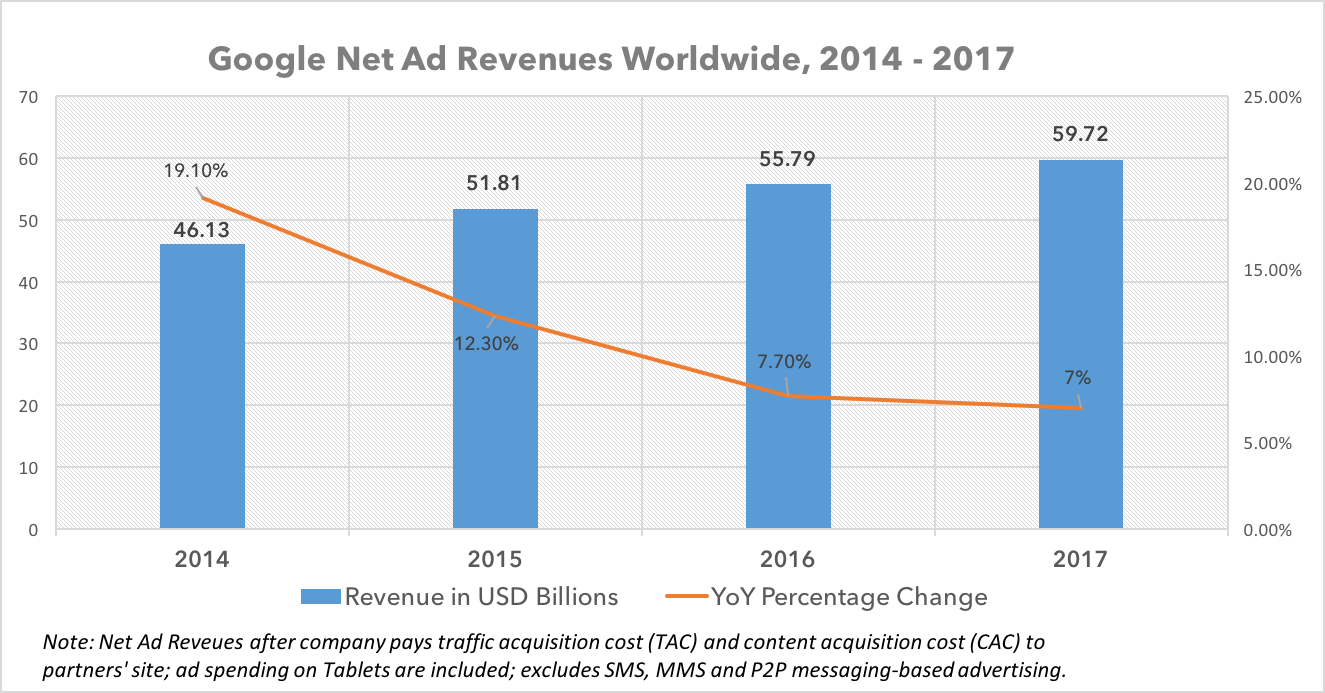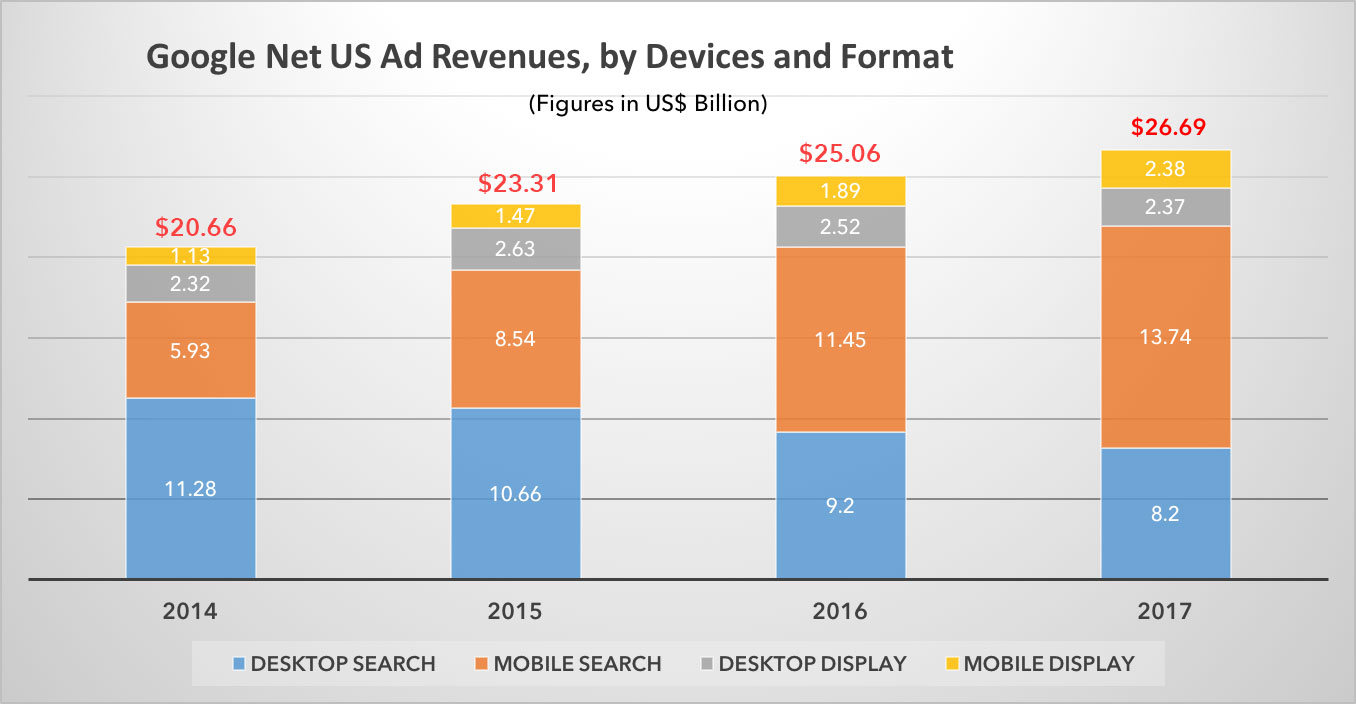For anyone who spends any amount of time on the Internet, Google, now a part of Alphabet Inc. (NASDAQ:GOOGL), has become ubiquitous with the term “search.” Hence, it comes as no surprise that, Google makes most of its money from the search business. They don’t ask money from people to use their products. Instead, they make money with ads. Be it on the desktop or mobile, if you’re using a Google product, chances are you’ve come across them, and this is what makes Google billions of dollars every year.
But, what if something was to happen to this flourishing ad empire. Can Google survive the transition from desktop to mobile ads, and, more importantly, can they keep pace with the changing choices of the Internet denizens who are increasingly becoming annoyed with traditional ads? There is a myriad of questions that Google has to answer in the coming months, and the changing habits of Internet users have brought a whole set of new challenges and new competitors in the Digital Ads Industry. A recent report by Emarketer forecasts a worrisome scenario for Google and today we analyse the reasons that could put a break on Google’s juggernaut.
Google’s Net Ad Revenues in A Smartphone Dominant Future
Till now, Google has always been able to push a double-digit growth on a YoY basis when it comes to their net ad revenue. The reason why we pay more importance on net ad revenue and it’s growth as compared to ad revenue for Google on a whole is the fact that these numbers are derived after subtracting the costs of Traffic and Content Acquisition to partner sites as well as ad spending on tablets. This gives us a clearer picture of the companies margins and growth patterns over the years. While 2015 is expected to follow the same trend, the growth rate is expected to slow down significantly especially when it comes to net Ad revenue. The latest projections of Google’s net Ad revenue reach $51.81 billion worldwide in 2015. That is an impressive number indeed but as we saw last week with Apple, investors are unforgiving when growth rates decline, despite how good the revenue figures might be. And there are a few strong indications that growth rates may indeed be down the hill as initial estimates are around the 12.3% mark. So what has changed from 2014, that has led to a fall in 6.8 percent points in net ad revenue growth? To find out, we take a deeper look at the breakdown of Google’s revenue streams, mobile as well as desktop.
It has been a year of contrast for Google. For the first time, mobile searches have beaten out desktops in terms of sheer volume and Google’s net ad revenue breakdowns reflect a similar story. With $51.81 billion in their kitty, Google commands over 30% share of the worldwide digital ad revenue. To put this into context, Facebook comes in at second place with only a measly 9.6% of digital ads revenue. Now while this is impressive, it’s time we take a look at the mobile segment. In a September estimate, eMarketer predicted that nearly 49.4% of Google’s net ad revenues would come from mobile-based ads.
Why is that significant? Because Google’s dominance is even more prominent in the mobile ad space. eMarketer estimates that nearly 33.7% of global mobile internet ad revenues in 2015 will belong to Google. Facebook again comes up second, though, this time, they manage to close the gap with 17.4% of the total revenue. In spite of that, their revenue from mobile ads languishes at about half of Google’s share.
Let’s see what is happening in US market. eMarketer expected mobile to account for less than half of Google’s search revenues for the calendar year, clocking in at nearly one-third of display earnings. However, mobile comes to the fore in search where mobile search is expected to contribute nearly 46% of Google’s net US revenues from as early as next year. On a different note, display ads are also growing in importance to Google’s revenues, specifically on the mobile side. As the importance of mobile grows, we see Google moving away from the traditional desktop ads to a new genre of rich media based ads that are based around Google’s video streaming service, Youtube.
A New Genre of Ads For a Mobile First Generation
As a quick look at the graph above will indicate a gradual but steady decline of the contribution of desktop ads to Google’s bottom line. This must not be mistaken as Google performing worse in the desktop market, but, on the contrary, the amount of market share that Google already has; combined with the reluctance of new players to join into the desktop ads arena, ensures that Google will continue to have majority market share in the desktop market for the foreseeable future. The steady decline of desktops ads from contributing over half the net revenue in 2014 to less than a third of the revenue in 2017 speaks volumes of the impending death of the PC.
Although this graph is US specific and the fact that it is a market with a high proliferation of smartphones has skewed the results in favor of mobile a fair bit, yet one can’t ignore the writing on the wall. Mobile ads, more specifically smartphone and tablet ads are going to be what drives the companies revenues with as much as 51% of the total income in the US estimated to be coming from search ads alone in 2017. Display ads also have a nearly 19% market share as we move into 2017 highlighting the need for diversification of ads sources from text and images to other forms of media.
Our suggestions for Google while devising its roadmap for mobile ads:
- Video ads are all set to play a big part in Google’s ad revenue as the investment in YouTube is set to pay off huge with services such as YouTube Red as well as display ads on the network. In fact, YouTube’s net ad revenues are estimated to reach $4.28 billion worldwide in 2015—up 40.6% YoY, according to eMarketer.
- Google will have to look into alternate forms of advertisement as we move into an app-centric smartphone environment. Google’s latest experiment of streaming apps from its own Search app may prove to be a masterstroke in the future.
- In order to maintain their growth rate, Google would need to expand their user base, and more projects like the Free Wifi Initiative would help them scale up organically and rapidly.
Summary
An analysis is never complete without looking at both sides of the coin and it is imperative that we bring out the possible pitfalls of Google’s strategy as it races ahead into 2016. While it is true that there is no reason to panic yet; but one can never be too wary and keeping one eye on your enemy’s tactics has been a tried and tested technique. So with that in mind, here are a few things that Google would do well to keep in mind as they head forward into the app-driven mobile search era.
- Innovative companies with a mobile-only strategy, like InMobi, could hamper Google’s market share. The app based ad industry is still in its infancy and with the financial prowess of Microsoft, a company like InMobi could quickly overtake Facebook in becoming Google’s nemesis.
- While YouTube seems to be on a roll as far as digital advertising is concerned, companies like Netflix and Hulu could quickly turn tables around especially by capturing new LTE markets by adding partnership deals with local Telecom networks.
- As the app market has skyrocketed, we see that piracy has stretched its evil hands for the profit of this budding industry as well. While not a major problem for big name publishers till now, Google needs to be on their toes to avoid getting caught in the web of fraudulent clicks.
- Innovation has its place but for Google, the staple of advertisement for the near future remains rooted in web ads. Apple with ad blocks in Safari browser presents one of the most imminent threats to Google’s revenue so far. It seems that even Samsung has joined their ranks with ad blocking capability being baked into their default browsers on Android.
How does Google deal with ad blocks? Diversification into different genres of advertisements seems to hold the answer.
“As Google continues to diversify its ad offerings we expect YouTube to play an increasingly important role in Alphabet’s earnings,” said eMarketer senior forecasting analyst Martín Utreras. “Additionally, mobile search revenues should continue to increase as more content within apps gets indexed by Google.”
So has Google managed to solve the advertising puzzle or will we witness the search bubble burst? While it seems unlikely that a transition to smartphones could make a behemoth like Google crumble, it will certainly be interesting to keep an eye on Google, and its competitors as they navigate through the maze of smartphone advertisements.



